Things to do in Xi An
Xi'an is a treasure trove for travellers interested in archaeology and ancient Chinese history. The Shaanxi History Museum stands as testament to the importance of this region in the development of Chinese culture. The museum houses about 370,000 artefacts collected in the area and is well worth a visit. Another exciting archaeological site is the Banpo Village, which dates back over 6, 000 years and is one of the most well-preserved and complete examples of an agricultural Neolithic settlement in the world. Xi'an is also home to the Forest of Steles, a collection of 3,000 steles (stone tablets and ancient inscriptions) collected over the centuries in a library that is a haven for travelling scholars or anyone interested in the history of language and the written word.
Of course, when it comes to sightseeing, Xi'an is synonymous with its foremost attraction: the famous Terracotta Army Museum. The collection of nearly 8,000 warriors, unearthed in 1974 is a not-to-be-missed experience for any visitor to China. The recently opened Tomb of Emperor Jingdi in Xi'an also displays a number of terracotta statues and it is a far less crowded museum. On the way to the Terracotta Army it is a good idea to stop off at the Huaqing Hot Springs to bathe in the same pools used by ancient emperors and their concubines.
The Xi'an city wall is one of the largest in the world and hiring a bicycle to cycle along the top is a wonderful introduction to the city. Travellers can also walk the wall, stopping along the way to take some amazing photographs of both ancient buildings and new age skyscrapers.
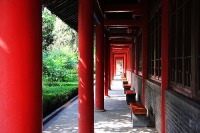
Forest of Steles
The Stele Forest in Xi'an, also called the Beilin Museum, contains more than 3,000 ancient standing stones, dating back to the Tang dynasty (618-907). The museum itself is nearly a…
Forest of Steles
The Stele Forest in Xi'an, also called the Beilin Museum, contains more than 3,000 ancient standing stones, dating back to the Tang dynasty (618-907). The museum itself is nearly as old, having been established in 1087. The steles are divided into seven exhibition halls, displaying classic examples of traditional Chinese calligraphy, painting and historical records. Travellers interested in history, writing and philosophy will delight in its collection, while English guides are recommended as a lot of the interesting cultural relevance of the inscriptions may otherwise be lost. The museum also enjoys lovely grounds with fountains, pagodas and a gift shop, making it a great place to relax after a long day of sightseeing.
Website www.beilin-museum.com
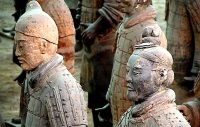
Qin Terracotta Army Museum
In 1974, a group of peasants digging a well in Lintong District unearthed fragments of a life-sized warrior figure. Further excavation revealed several timber-lined vaults filled w…
Qin Terracotta Army Museum
In 1974, a group of peasants digging a well in Lintong District unearthed fragments of a life-sized warrior figure. Further excavation revealed several timber-lined vaults filled with thousands of greatly detailed terracotta soldiers, horses and chariots: an entire army assembled in position to follow their Emperor Qin into eternity. The pits are now open to public viewing and thousands of visitors flock to gaze at the stunning array of figures with their vivid facial expressions.
The Terracotta Army Museum consists of the original pit that was discovered in 1974, which has been enclosed to preserve the ranks of 6,000 soldiers found there. A second pit, containing 1,400 figures of cavalrymen, horses and infantrymen, and 90 wooden chariots, is also part of the museum.
Visitors can also see Qin's Mausoleum and view almost 100 sacrificial pits containing the skeletons of horses buried with him. There are also about 20 tombs holding the remains of his counsellors and retainers. The emperor's tomb itself is under a 249-foot (76m) high mound that has not yet been excavated, but is believed, according to historical records, to have contained rare gems and other treasures.
Website www.bmy.com.cn
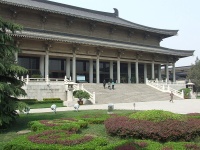
Shaanxi Provincial History Museum
The graceful complex of the Shaanxi Provincial History Museum is built in the style of a Tang dynasty pavilion, itself a staggering sight. The museum's exhibits are even more breat…
Shaanxi Provincial History Museum
The graceful complex of the Shaanxi Provincial History Museum is built in the style of a Tang dynasty pavilion, itself a staggering sight. The museum's exhibits are even more breathtaking, consisting of about 113,000 artefacts unearthed in the province and chronologically arranged in three exhibition halls. The exhibits cover the Han, Wei, Jin, North and South, Sui, Tang, Song, Yuan, Ming and Qing dynasties, as well as the prehistoric and bronze period. Shaanxi province was a vital region for the cultural development of China, and the capital of 13 glorious dynasties. The Shaanxi Provincial History Museum stands as testament to the area's importance, serving as China's premier, world-class history museum. Travellers are advised to get there early to avoid massive queues.
Website www.sxhm.com
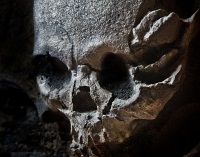
Banpo Village Remains
The remains of the ancient settlement of Banpo, dating from about 5000 BC, are found in the Yellow River Valley east of Xi'an. The site makes up one of the most complete examples o…
Banpo Village Remains
The remains of the ancient settlement of Banpo, dating from about 5000 BC, are found in the Yellow River Valley east of Xi'an. The site makes up one of the most complete examples of an agricultural Neolithic settlement in the world. It contains the ruins of more than 40 homes, 200 cellars, a collection of pottery and tools, and more than 250 graves belonging to a matriarchal community of the Yangshao culture.
There is an on-site museum, with two smaller exhibition halls displaying various archaeological artefacts that have been unearthed in the area. More than 400 archaeological sites similar to Banpo have been discovered in and around the Yellow River Valley in China, giving the area the reputation of being the birthplace of ancient Chinese culture.
Website www.banpomuseum.com.cn
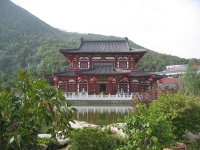
Huaqing Hot Springs
The Huaqing Hot Springs at the base of the Lishan Mountains is where ancient emperors bathed and relaxed. Huaqing is one of the Hundred Famous Gardens of China and the setting is t…
Huaqing Hot Springs
The Huaqing Hot Springs at the base of the Lishan Mountains is where ancient emperors bathed and relaxed. Huaqing is one of the Hundred Famous Gardens of China and the setting is tranquil and beautiful. The spa has been operating for more than 12 centuries and its warm mineral waters, containing lime, sodium carbonate and sodium sulphate, are still enjoyed by locals and visitors today. The waters are particularly recommended for the treatment of dermatitis, rheumatism, arthritis and muscular pain. Even the Hibiscus Pool, dating from the year 712 and having been restored, is open to the public. There is also a fascinating museum at the site containing building materials from the Tang Dynasty. Another attraction at the springs is the Hovering Rainbow Bridge, which reflects the sunset in such a way that it appears to be a rainbow. Visitors can also take a cable car up to take in marvellous mountain vistas.
Website www.visitourchina.com/xian/attraction/huaqing-hot-springs.html
Great Mosque
The Great Mosque is the pride of China's Islamic community, with the religion arriving in the country along with Arab merchants and travellers in roughly the year 600. The Great Mo…
Great Mosque
The Great Mosque is the pride of China's Islamic community, with the religion arriving in the country along with Arab merchants and travellers in roughly the year 600. The Great Mosque in Xi'an is the best-preserved ancient mosque in China, having been built in 742. It is built in traditional Chinese style with platforms, pavilions and halls, and is divided inside into four courtyards. Visitors can explore the passages, courtyards and archways, with furnishings dating from the Ming and Qing dynasties.
The main prayer hall can accommodate 1,000 worshippers and its ceiling bears more than 600 classical scriptures in colourful relief. This unique mix of Islamic and Chinese architecture is surrounded by landscaped gardens, ideal for quiet sanctuary and contemplative walks. It remains a place of worship, so visitors should dress appropriately and behave respectfully.



